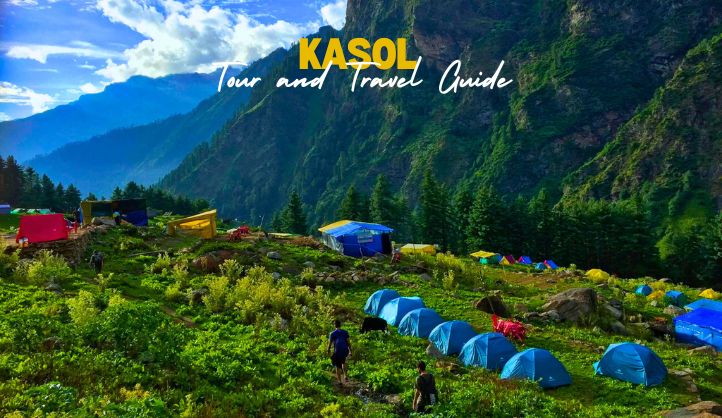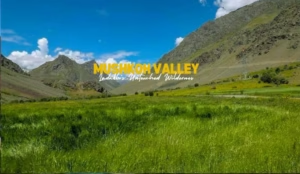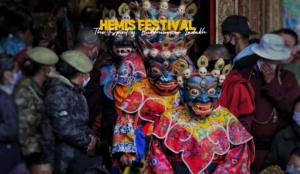Kasol, often referred to as the “Mini Israel” of India, is a picturesque village located in the Parvati Valley of Himachal Pradesh. Nestled along the banks of the Parvati River, this small town has gained immense popularity among young travelers, backpackers, and nature enthusiasts. Known for its stunning landscapes, vibrant culture, and a unique blend of Israeli and Himachali influences, Kasol offers a plethora of experiences that cater to various types of visitors.
History and Cultural Significance
Kasol was once a sleepy village, primarily inhabited by locals who engaged in agriculture and cattle rearing. Over the years, its natural beauty and strategic location near the Kullu-Manali circuit drew tourists from around the globe. The influx of Israeli tourists in particular has left a lasting imprint on Kasol’s culture, evident in the local cuisine, cafes, and even Hebrew signboards.
The village serves as a gateway to other mesmerizing destinations like Manikaran, Tosh, Malana, and Kheerganga, making it a vital stop on the Parvati Valley trail.
Why Kasol is a Popular Tourist Destination
1. Scenic Treks
Kasol is a starting point for several treks that cater to both beginners and seasoned trekkers.
- Kheerganga Trek: Known for its hot water springs and mesmerizing views of the valley.
- Tosh Trek: Offers a blend of nature and culture as you ascend to this quaint village.
- Malana Trek: Famous for its unique traditions and isolated community.
2. Adventure Activities
From trekking to camping, Kasol is a paradise for adventure enthusiasts. The village offers opportunities for rock climbing, river crossing, and even trout fishing.
3. Cafes and Cuisine
Kasol is dotted with vibrant cafes serving Israeli, Indian, and continental cuisines. Some of the must-visit cafes include:
- Jim Morrison Cafe
- Bhoj Cafe
- Moon Dance Cafe
4. Shopping
The local flea market in Kasol is perfect for picking up souvenirs like handmade jewelry, woolen garments, and traditional Himachali items.
5. Cultural Mix
Kasol’s fusion of Himachali and Israeli cultures creates a unique ambiance that is both welcoming and intriguing.
How to Reach Kasol
Getting to Kasol is an adventure in itself, with scenic routes that set the tone for your trip.
By Air
- The nearest airport is Kullu-Manali Airport (Bhuntar), about 31 km away. You can take a taxi or a local bus to Kasol from Bhuntar.
- Flights to Bhuntar are limited, so consider flying to Chandigarh or Delhi and traveling by road.
By Train
- The closest railway station is Joginder Nagar Railway Station, approximately 145 km away.
- For a more convenient option, take a train to Chandigarh or Pathankot and continue the journey by road.
By Road
- From Delhi: Kasol is about 520 km (12-14 hours by road). Direct buses to Bhuntar are available from ISBT Delhi. From Bhuntar, you can hire a cab or board a local bus to Kasol.
- From Chandigarh: The 270 km journey takes about 7-8 hours. Regular buses ply between Chandigarh and Bhuntar.
Pro Tip: Opt for a private car or taxi for a more comfortable journey, especially if you’re traveling with family or friends.
Best Time to Visit
kasol’s charm changes with the seasons, offering unique experiences year-round:
- March to June (Summer): Perfect weather with temperatures ranging from 15°C to 25°C. Ideal for trekking, camping, and enjoying outdoor activities.
- July to August (Monsoon): Though lush and green, heavy rainfall can make trekking trails slippery and risky.
- September to November (Autumn): Clear skies and vibrant landscapes make it a favorite for nature lovers and photographers.
- December to February (Winter): Snow-covered mountains and a chill in the air create a magical winter wonderland. This is the best time for snow trekking.
Tour Itinerary
A well-planned itinerary can enhance your experience in Kasol. Here’s a suggested four-day itinerary:
Day 1: Arrival in Kasol
- Reach Kasol via your chosen mode of transport.
- Check into your accommodation.
- Explore local cafes and enjoy dinner with scenic views.
Day 2: Local Exploration
- Visit Gurudwara Shri Manikaran Sahib.
- Spend time by the Parvati River.
- Explore local markets for shopping.
Day 3: Trekking Adventure
- Choose between the Kheerganga or Malana trek based on your preference.
- Enjoy the natural beauty along the trekking route.
Day 4: Departure
- Relax in Kasol before heading back.
- Take some time for last-minute shopping or café hopping before departure.
Nearby Places to Explore Around Kasol
Kasol is beautifully nestled in the Parvati Valley, surrounded by mesmerizing landscapes and charming villages. If you’re planning a trip to Kasol, there are several nearby destinations worth visiting. Here are some must-explore places around Kasol:
1. Manikaran
- Famous For: Spiritual significance, hot springs, and Gurudwara.
- Why Visit: Manikaran is known for its sacred Gurudwara, Manikaran Sahib, and natural hot springs believed to have medicinal properties. The town is located at the confluence of the Parvati and Beas rivers. Pilgrims visit this place to take a dip in the hot springs for spiritual and health benefits.
- Things to Do:
- Visit Manikaran Sahib Gurudwara and take a holy dip in the hot springs.
- Explore the local temples, including the Ram Temple and Shiva Temple.
- Enjoy the beautiful river view and the surrounding mountains.
2. Tosh Village
- Famous For: Scenic beauty and relaxed vibe.
- Why Visit: Tosh is a picturesque village located at the end of the Parvati Valley. The village is known for its serene environment, stunning mountain views, and traditional wooden houses. It’s an ideal place for those looking to escape the hustle and bustle of the more touristy areas.
- Things to Do:
- Go for a trek to Tosh Waterfall.
- Explore the local cafes offering delicious food and enjoy the laid-back atmosphere.
- Visit the ancient temples and enjoy the majestic mountain views.
3. Kheerganga
- Famous For: Trekking and natural hot springs.
- Why Visit: Kheerganga is a famous trekking destination in Kasol and Parvati Valley. Known for its natural hot spring and breathtaking views of snow-capped mountains, it’s a popular spot for trekkers and adventure enthusiasts.
- Things to Do:
- Trek to Kheerganga – A moderate 12-14 km trek with scenic views and forest cover.
- Relax in the natural hot spring and enjoy panoramic views of the Parvati Valley.
- Camp under the stars for an unforgettable experience.
4. Malana Village
- Famous For: Unique culture, ancient history, and cannabis cultivation.
- Why Visit: Malana is one of the oldest villages in the region and is known for its unique culture, language, and history. The village is often called the “Little Greece of India” because of its distinct heritage. It is also famous for its cannabis cultivation, which is considered the best in the region.
- Things to Do:
- Visit the Malana Temple dedicated to Jamlu Rishi, the village deity.
- Explore the local lifestyle, which remains untouched by modern influence.
- Hike the Malana Trek for spectacular views of the Parvati Valley.
5. Pulga
- Famous For: Serene beauty and peaceful surroundings.
- Why Visit: Pulga is a small village situated amidst lush greenery and surrounded by majestic snow-covered peaks. It’s less crowded compared to Kasol and offers a peaceful retreat for travelers looking to immerse themselves in nature.
- Things to Do:
- Enjoy a quiet stay in the village’s homestays and experience the local culture.
- Visit the Pulga Temple and take a walk by the river.
- Enjoy the surrounding apple orchards and local fauna.
6. Bhuntar
- Famous For: Gateway to the Parvati Valley and Kullu.
- Why Visit: Bhuntar is the closest town to Kasol and serves as a base for travelers heading to Manali, Kullu, or the nearby villages. While the town itself is not a major tourist attraction, it offers access to several scenic spots and adventure activities.
- Things to Do:
- Visit Bijli Mahadev Temple, situated at a height of 2,460 meters.
- Explore the scenic beauty of Sultanpur village and surrounding nature.
- Enjoy the local markets for souvenirs and snacks.
7. Naggar
- Famous For: Historical significance and art galleries.
- Why Visit: Naggar is a historical town that served as the capital of the Kullu kingdom for several centuries. Today, it is famous for its heritage buildings, temples, and scenic views. The town is also known for its Naggar Castle and the Roerich Art Gallery, which showcases the works of the Russian painter Nicholas Roerich.
- Things to Do:
- Explore the Naggar Castle, a 16th-century building offering panoramic views of the Kullu Valley.
- Visit the Roerich Art Gallery and learn about the works of Nicholas Roerich.
- Take a stroll through the village to admire its traditional wooden houses and temples.
8. Rumsu
- Famous For: Riverside beauty and local culture.
- Why Visit: Rumsu is a lesser-known village in the Kullu Valley, surrounded by lush pine forests and the gentle flow of the Beas River. It offers a peaceful retreat with fewer tourists, making it perfect for nature lovers.
- Things to Do:
- Trek to the Rumsu Village for panoramic views of the mountains and the river.
- Visit the Rumsu Temple and interact with the locals to learn about their lifestyle.
- Enjoy a picnic by the riverside and immerse in the tranquility of the region.
Tips for Travelers
- Pack Wisely: Carry essentials such as trekking shoes, warm clothing (especially during winter), sunscreen, and personal medications.
- Stay Hydrated: Drink plenty of water while trekking or exploring.
- Respect Local Customs: Be mindful of local traditions when visiting villages or religious sites.
- Cash Availability: While ATMs are available in Kasol, it’s advisable to carry cash as some places may not accept cards.
- Travel Insurance: Consider getting travel insurance that covers trekking activities for peace of mind during your adventures.
Conclusion
Kasol is more than just a travel destination; it’s an experience that stays with you long after your visit. Whether you’re an adventurer, a peace-seeker, or someone looking to explore a unique cultural blend, Kasol offers something for everyone. With its stunning landscapes, welcoming community, and myriad activities, this enchanting hamlet is a must-visit for every traveler.
So pack your bags, put on your trekking boots, and get ready to explore the mesmerizing village of Kasol, where every moment feels like a walk through paradise.
FAQs about Kasol Tour and Travel
Here are some frequently asked questions (FAQs) about Kasol, which will help you plan your trip better:
1. Where is Kasol located?
Kasol is located in the Parvati Valley of Himachal Pradesh, India, approximately 30 kilometers from Kullu. It is situated along the Parvati River and is known for its natural beauty and serene atmosphere.
2. How do I reach Kasol?
Kasol is well-connected by road and can be reached via several means:
- By Air: The nearest airport is in Bhuntar, 31 kilometers away. From Bhuntar, you can take a taxi or bus to reach Kasol.
- By Train: The nearest railway station is in Kullu (about 30 km away) or Joginder Nagar (about 125 km). You can take a taxi or bus from there to Kasol.
- By Road: Kasol is accessible by buses and taxis from major cities like Delhi, Chandigarh, and Manali. Private vehicles and shared taxis are also available for a scenic drive to Kasol.
3. When is the best time to visit Kasol?
The best time to visit Kasol is:
- Summer (March to June): The weather is pleasant, and it’s ideal for outdoor activities like trekking, fishing, and exploring the local culture.
- Winter (December to February): If you enjoy snow and winter sports like skiing, December to February is perfect. However, the temperatures can be quite low, so be prepared for cold weather.
- Monsoon (July to September): While the region becomes lush and green during the monsoon, the roads can be slippery, and landslides may occur, making it less ideal for travel.
4. What are the popular attractions in and around Kasol?
Some of the popular attractions include:
- Manikaran Sahib Gurudwara and hot springs
- Kheerganga – famous for its natural hot springs and trekking opportunities
- Tosh Village – for a peaceful retreat and stunning views
- Malana Village – known for its unique culture and history
- Great Himalayan National Park – a UNESCO World Heritage Site
- Riverside cafes for local delicacies and chill vibes
5. What is the best way to travel around Kasol?
Kasol is a small village, and the best way to explore it is by walking. For nearby destinations like Manikaran or Tosh, taxis and local buses are available. You can also rent a scooter or bike to travel around and enjoy the scenic beauty.
6. Is Kasol safe for solo travelers?
Yes, Kasol is generally considered safe for solo travelers. The place attracts a lot of backpackers, especially from Europe and Israel. However, as with any travel destination, it’s advisable to take general precautions:
- Avoid venturing out late at night.
- Be cautious of your belongings in crowded areas.
- Stick to well-known routes and stay in reputed accommodations.
7. What are the adventure activities to do in Kasol?
Kasol is famous for outdoor and adventure activities, including:
- Trekking: Popular treks include the Kheerganga Trek, Malana Trek, and Tosh Trek.
- Camping: You can camp at various spots like Kheerganga, Tosh, and other nearby areas.
- Fishing: The Parvati River is famous for fishing, especially for trout.
- Paragliding and River Rafting: Available in nearby areas like Solang Valley and Bhuntar.
- Hot Springs: Relax in the natural hot springs in Manikaran and Kheerganga.
8. What is the local cuisine like in Kasol?
Kasol offers a variety of local and international cuisine. You can enjoy:
- Israeli food: Kasol is often referred to as “Mini Israel” due to the large number of Israeli travelers. You can try dishes like Shakshuka, Falafel, and Hummus.
- Indian food: Local Himachali dishes like Siddu, Chana Madra, and Dham are a must-try.
- Bakeries: Kasol has several cafes and bakeries where you can enjoy freshly baked bread, pastries, and cakes.





